Mingxuan Yuan
Towards Efficient Agents: A Co-Design of Inference Architecture and System
Dec 20, 2025Abstract:The rapid development of large language model (LLM)-based agents has unlocked new possibilities for autonomous multi-turn reasoning and tool-augmented decision-making. However, their real-world deployment is hindered by severe inefficiencies that arise not from isolated model inference, but from the systemic latency accumulated across reasoning loops, context growth, and heterogeneous tool interactions. This paper presents AgentInfer, a unified framework for end-to-end agent acceleration that bridges inference optimization and architectural design. We decompose the problem into four synergistic components: AgentCollab, a hierarchical dual-model reasoning framework that balances large- and small-model usage through dynamic role assignment; AgentSched, a cache-aware hybrid scheduler that minimizes latency under heterogeneous request patterns; AgentSAM, a suffix-automaton-based speculative decoding method that reuses multi-session semantic memory to achieve low-overhead inference acceleration; and AgentCompress, a semantic compression mechanism that asynchronously distills and reorganizes agent memory without disrupting ongoing reasoning. Together, these modules form a Self-Evolution Engine capable of sustaining efficiency and cognitive stability throughout long-horizon reasoning tasks. Experiments on the BrowseComp-zh and DeepDiver benchmarks demonstrate that through the synergistic collaboration of these methods, AgentInfer reduces ineffective token consumption by over 50%, achieving an overall 1.8-2.5 times speedup with preserved accuracy. These results underscore that optimizing for agentic task completion-rather than merely per-token throughput-is the key to building scalable, efficient, and self-improving intelligent systems.
SCOPE: Prompt Evolution for Enhancing Agent Effectiveness
Dec 17, 2025Abstract:Large Language Model (LLM) agents are increasingly deployed in environments that generate massive, dynamic contexts. However, a critical bottleneck remains: while agents have access to this context, their static prompts lack the mechanisms to manage it effectively, leading to recurring Corrective and Enhancement failures. To address this capability gap, we introduce \textbf{SCOPE} (Self-evolving Context Optimization via Prompt Evolution). SCOPE frames context management as an \textit{online optimization} problem, synthesizing guidelines from execution traces to automatically evolve the agent's prompt. We propose a Dual-Stream mechanism that balances tactical specificity (resolving immediate errors) with strategic generality (evolving long-term principles). Furthermore, we introduce Perspective-Driven Exploration to maximize strategy coverage, increasing the likelihood that the agent has the correct strategy for any given task. Experiments on the HLE benchmark show that SCOPE improves task success rates from 14.23\% to 38.64\% without human intervention. We make our code publicly available at https://github.com/JarvisPei/SCOPE.
Re$^{\text{2}}$MaP: Macro Placement by Recursively Prototyping and Packing Tree-based Relocating
Nov 11, 2025Abstract:This work introduces the Re$^{\text{2}}$MaP method, which generates expert-quality macro placements through recursively prototyping and packing tree-based relocating. We first perform multi-level macro grouping and PPA-aware cell clustering to produce a unified connection matrix that captures both wirelength and dataflow among macros and clusters. Next, we use DREAMPlace to build a mixed-size placement prototype and obtain reference positions for each macro and cluster. Based on this prototype, we introduce ABPlace, an angle-based analytical method that optimizes macro positions on an ellipse to distribute macros uniformly near chip periphery, while optimizing wirelength and dataflow. A packing tree-based relocating procedure is then designed to jointly adjust the locations of macro groups and the macros within each group, by optimizing an expertise-inspired cost function that captures various design constraints through evolutionary search. Re$^{\text{2}}$MaP repeats the above process: Only a subset of macro groups are positioned in each iteration, and the remaining macros are deferred to the next iteration to improve the prototype's accuracy. Using a well-established backend flow with sufficient timing optimizations, Re$^{\text{2}}$MaP achieves up to 22.22% (average 10.26%) improvement in worst negative slack (WNS) and up to 97.91% (average 33.97%) improvement in total negative slack (TNS) compared to the state-of-the-art academic placer Hier-RTLMP. It also ranks higher on WNS, TNS, power, design rule check (DRC) violations, and runtime than the conference version ReMaP, across seven tested cases. Our code is available at https://github.com/lamda-bbo/Re2MaP.
MOSS: Efficient and Accurate FP8 LLM Training with Microscaling and Automatic Scaling
Nov 08, 2025Abstract:Training large language models with FP8 formats offers significant efficiency gains. However, the reduced numerical precision of FP8 poses challenges for stable and accurate training. Current frameworks preserve training performance using mixed-granularity quantization, i.e., applying per-group quantization for activations and per-tensor/block quantization for weights. While effective, per-group quantization requires scaling along the inner dimension of matrix multiplication, introducing additional dequantization overhead. Moreover, these frameworks often rely on just-in-time scaling to dynamically adjust scaling factors based on the current data distribution. However, this online quantization is inefficient for FP8 training, as it involves multiple memory reads and writes that negate the performance benefits of FP8. To overcome these limitations, we propose MOSS, a novel FP8 training framework that ensures both efficiency and numerical stability. MOSS introduces two key innovations: (1) a two-level microscaling strategy for quantizing sensitive activations, which balances precision and dequantization cost by combining a high-precision global scale with compact, power-of-two local scales; and (2) automatic scaling for weights in linear layers, which eliminates the need for costly max-reduction operations by predicting and adjusting scaling factors during training. Leveraging these techniques, MOSS enables efficient FP8 training of a 7B parameter model, achieving performance comparable to the BF16 baseline while achieving up to 34% higher training throughput.
Beyond Tokens: Enhancing RTL Quality Estimation via Structural Graph Learning
Aug 26, 2025



Abstract:Estimating the quality of register transfer level (RTL) designs is crucial in the electronic design automation (EDA) workflow, as it enables instant feedback on key metrics like area and delay without the need for time-consuming logic synthesis. While recent approaches have leveraged large language models (LLMs) to derive embeddings from RTL code and achieved promising results, they overlook the structural semantics essential for accurate quality estimation. In contrast, the control data flow graph (CDFG) view exposes the design's structural characteristics more explicitly, offering richer cues for representation learning. In this work, we introduce a novel structure-aware graph self-supervised learning framework, StructRTL, for improved RTL design quality estimation. By learning structure-informed representations from CDFGs, our method significantly outperforms prior art on various quality estimation tasks. To further boost performance, we incorporate a knowledge distillation strategy that transfers low-level insights from post-mapping netlists into the CDFG predictor. Experiments show that our approach establishes new state-of-the-art results, demonstrating the effectiveness of combining structural learning with cross-stage supervision.
ELF: Efficient Logic Synthesis by Pruning Redundancy in Refactoring
Aug 11, 2025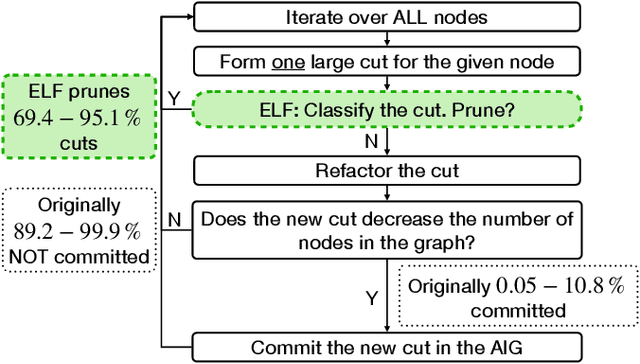
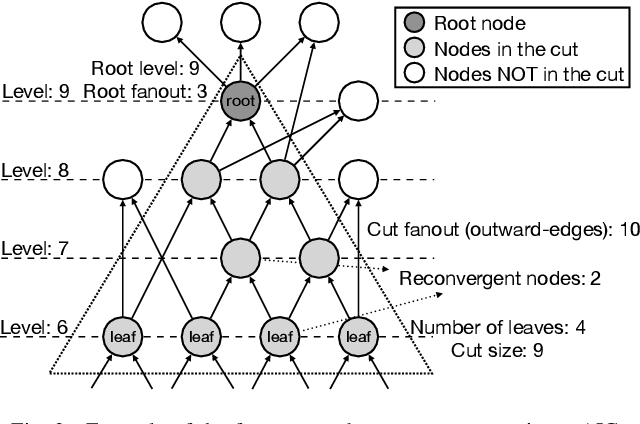
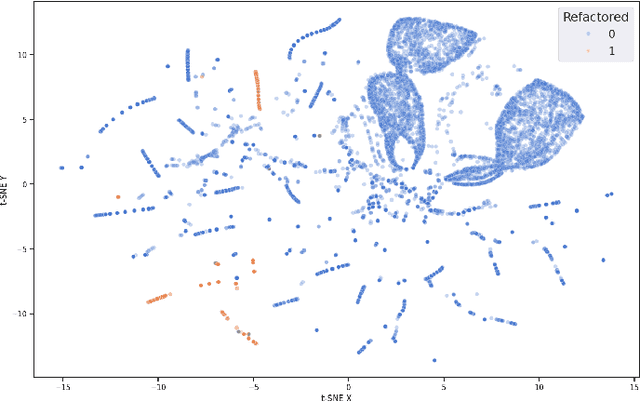
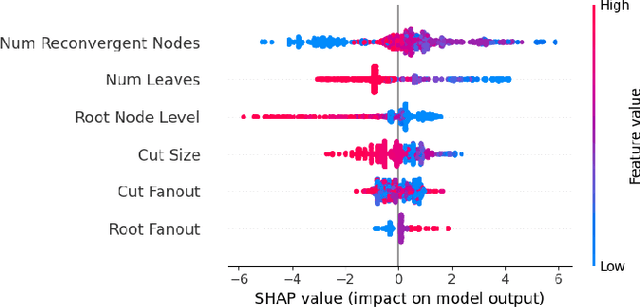
Abstract:In electronic design automation, logic optimization operators play a crucial role in minimizing the gate count of logic circuits. However, their computation demands are high. Operators such as refactor conventionally form iterative cuts for each node, striving for a more compact representation - a task which often fails 98% on average. Prior research has sought to mitigate computational cost through parallelization. In contrast, our approach leverages a classifier to prune unsuccessful cuts preemptively, thus eliminating unnecessary resynthesis operations. Experiments on the refactor operator using the EPFL benchmark suite and 10 large industrial designs demonstrate that this technique can speedup logic optimization by 3.9x on average compared with the state-of-the-art ABC implementation.
Discovering Interpretable Programmatic Policies via Multimodal LLM-assisted Evolutionary Search
Aug 07, 2025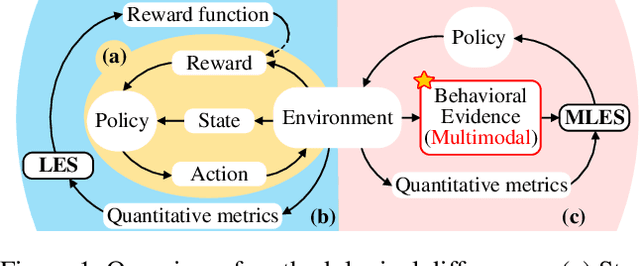
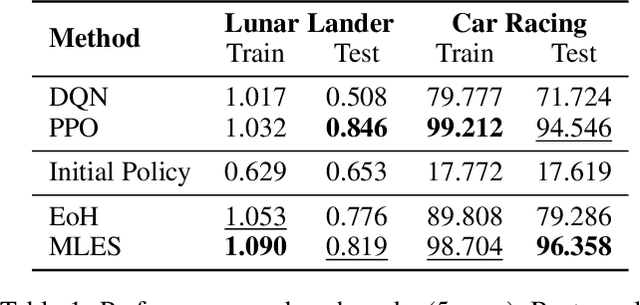
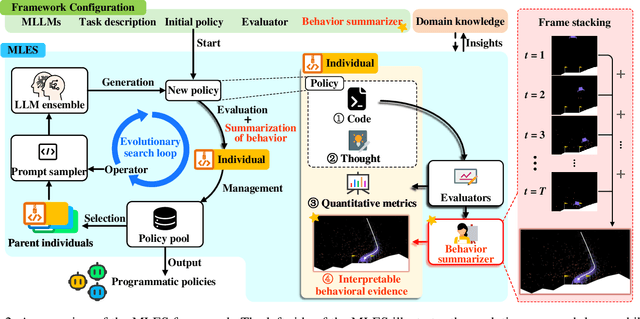
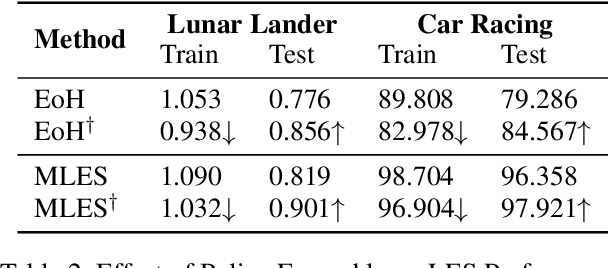
Abstract:Interpretability and high performance are essential goals in designing control policies, particularly for safety-critical tasks. Deep reinforcement learning has greatly enhanced performance, yet its inherent lack of interpretability often undermines trust and hinders real-world deployment. This work addresses these dual challenges by introducing a novel approach for programmatic policy discovery, called Multimodal Large Language Model-assisted Evolutionary Search (MLES). MLES utilizes multimodal large language models as policy generators, combining them with evolutionary mechanisms for automatic policy optimization. It integrates visual feedback-driven behavior analysis within the policy generation process to identify failure patterns and facilitate targeted improvements, enhancing the efficiency of policy discovery and producing adaptable, human-aligned policies. Experimental results show that MLES achieves policy discovery capabilities and efficiency comparable to Proximal Policy Optimization (PPO) across two control tasks, while offering transparent control logic and traceable design processes. This paradigm overcomes the limitations of predefined domain-specific languages, facilitates knowledge transfer and reuse, and is scalable across various control tasks. MLES shows promise as a leading approach for the next generation of interpretable control policy discovery.
PreMoe: Lightening MoEs on Constrained Memory by Expert Pruning and Retrieval
May 23, 2025



Abstract:Mixture-of-experts (MoE) architectures enable scaling large language models (LLMs) to vast parameter counts without a proportional rise in computational costs. However, the significant memory demands of large MoE models hinder their deployment across various computational environments, from cloud servers to consumer devices. This study first demonstrates pronounced task-specific specialization in expert activation patterns within MoE layers. Building on this, we introduce PreMoe, a novel framework that enables efficient deployment of massive MoE models in memory-constrained environments. PreMoe features two main components: probabilistic expert pruning (PEP) and task-adaptive expert retrieval (TAER). PEP employs a new metric, the task-conditioned expected selection score (TCESS), derived from router logits to quantify expert importance for specific tasks, thereby identifying a minimal set of critical experts. TAER leverages these task-specific expert importance profiles for efficient inference. It pre-computes and stores compact expert patterns for diverse tasks. When a user query is received, TAER rapidly identifies the most relevant stored task pattern and reconstructs the model by loading only the small subset of experts crucial for that task. This approach dramatically reduces the memory footprint across all deployment scenarios. DeepSeek-R1 671B maintains 97.2\% accuracy on MATH500 when pruned to 8/128 configuration (50\% expert reduction), and still achieves 72.0\% with aggressive 8/32 pruning (87.5\% expert reduction). Pangu-Ultra-MoE 718B achieves 97.15\% on MATH500 and 81.3\% on AIME24 with 8/128 pruning, while even more aggressive pruning to 4/64 (390GB memory) preserves 96.95\% accuracy on MATH500. We make our code publicly available at https://github.com/JarvisPei/PreMoe.
TrimR: Verifier-based Training-Free Thinking Compression for Efficient Test-Time Scaling
May 22, 2025



Abstract:Large Reasoning Models (LRMs) demonstrate exceptional capability in tackling complex mathematical, logical, and coding tasks by leveraging extended Chain-of-Thought (CoT) reasoning. Test-time scaling methods, such as prolonging CoT with explicit token-level exploration, can push LRMs' accuracy boundaries, but they incur significant decoding overhead. A key inefficiency source is LRMs often generate redundant thinking CoTs, which demonstrate clear structured overthinking and underthinking patterns. Inspired by human cognitive reasoning processes and numerical optimization theories, we propose TrimR, a verifier-based, training-free, efficient framework for dynamic CoT compression to trim reasoning and enhance test-time scaling, explicitly tailored for production-level deployment. Our method employs a lightweight, pretrained, instruction-tuned verifier to detect and truncate redundant intermediate thoughts of LRMs without any LRM or verifier fine-tuning. We present both the core algorithm and asynchronous online system engineered for high-throughput industrial applications. Empirical evaluations on Ascend NPUs and vLLM show that our framework delivers substantial gains in inference efficiency under large-batch workloads. In particular, on the four MATH500, AIME24, AIME25, and GPQA benchmarks, the reasoning runtime of Pangu-R-38B, QwQ-32B, and DeepSeek-R1-Distill-Qwen-32B is improved by up to 70% with negligible impact on accuracy.
Harnessing On-Device Large Language Model: Empirical Results and Implications for AI PC
May 22, 2025Abstract:The increasing deployment of Large Language Models (LLMs) on edge devices, driven by model advancements and hardware improvements, offers significant privacy benefits. However, these on-device LLMs inherently face performance limitations due to reduced model capacity and necessary compression techniques. To address this, we introduce a systematic methodology -- encompassing model capability, development efficiency, and system resources -- for evaluating on-device LLMs. Our comprehensive evaluation, encompassing models from 0.5B to 14B parameters and seven post-training quantization (PTQ) methods on commodity laptops, yields several critical insights: 1) System-level metrics exhibit near-linear scaling with effective bits-per-weight (BPW). 2) A practical threshold exists around $\sim$3.5 effective BPW, larger models subjected to low-bit quantization consistently outperform smaller models utilizing higher bit-precision. 3) Quantization with low BPW incurs marginal accuracy loss but significant memory savings. 4) Determined by low-level implementation specifics power consumption on CPU, where computation-intensive operations spend more power than memory-intensive ones. These findings offer crucial insights and practical guidelines for the efficient deployment and optimized configuration of LLMs on resource-constrained edge devices. Our codebase is available at https://github.com/simmonssong/LLMOnDevice.
 Add to Chrome
Add to Chrome Add to Firefox
Add to Firefox Add to Edge
Add to Edge